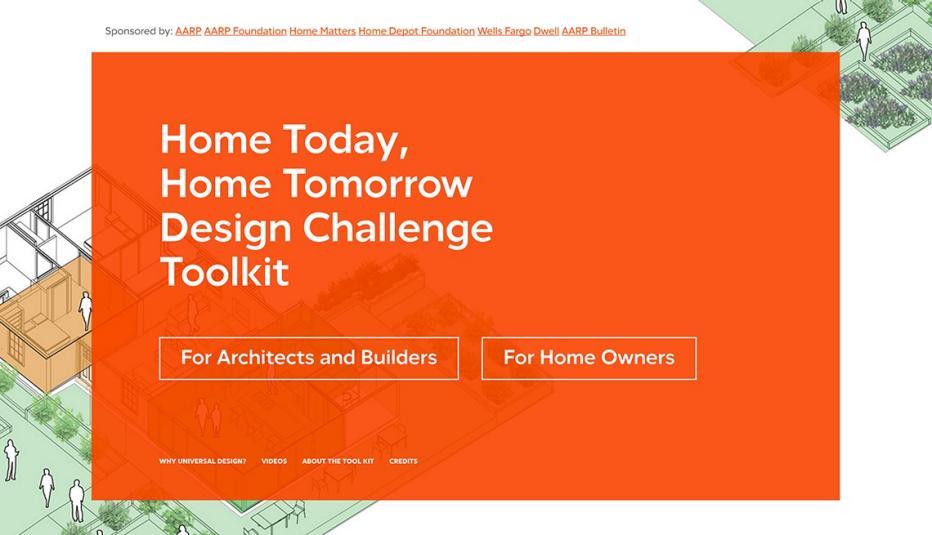AARP Hearing Center
Latest News:


AARP’s Accessory Dwelling Units: A Step by Step Guide to Design and Development is an ADU Design Catalog for homeowners, builders and local stakeholders who are interested in learning more about ADUs and expanding housing options within the community. The catalog includes:


• A summary of ADU regulations for four cities: Austin, TX; Denver, Co; Oakland, CA; and the District of Columbia
• Useful tools and resources about financing and budgeting for an ADU project
• Visuals that highlight potential features and components for inclusion in the design and build of an ADU
• Drawings that include design elements that can make an ADU more accessible for someone who wants to age in their home or a person with limited mobility
Home Today, Home Tomorrow Design Challenge Toolkit:
AARP, AARP Foundation and its partners recently released the Home Today, Home Tomorrow Design Challenge Toolkit. The Toolkit provides ideas and tips on how to remodel your home so your home can grow with you and your family. The toolkit illustrates universal design features to meet the needs of homeowners at any life stage. Learn more: http://www.homemattersamerica.com/designchallengetoolkit/
In February 2017, a first-of-its-kind home adhering to the standard of “ageless design” was unveiled in Memphis, TN. The home is part of a groundbreaking effort by AARP, AARP Foundation, Home Matters and the Wells Fargo Housing Foundation, which challenged architects through a nationwide competition to create new standards in housing design that allow adults to stay in their homes throughout their lives. A 54-year old U.S. Army veteran, Walter Moody, will live in the home.
Jo Ann Jenkins, CEO of AARP shared her thoughts about the event: “An overwhelming majority of older people want to stay in their homes and communities as they age,” said. “This ‘ageless design’ contest provides a strong example of what we as a society need to do to help make this a reality. With 10,000 Americans turning 65 each day, this competition is a wake-up call that we need better solutions that allow people to have more control over how and where they live.”
Lisa Marsh Ryerson, president of AARP Foundation, who also spoke at the unveiling, stated, “We view housing as the linchpin of well-being. It’s what drives our support for innovative designs that reshape the future of housing. We all want a home that can adapt to our needs as we age. This competition brings workable housing options to life so people of all income levels, including the most vulnerable seniors, can see that independent living is possible for them.”
The first-place design, by IBI Group – Gruzen Samton, has been incorporated into the Memphis home, which was donated by Wells Fargo in coordination with Home Matters’ on-the-ground partner, United Housing, Inc. (UHI), and with The Home Depot Foundation’s donation of materials and volunteer support.
Video: Re-defining Home: Home Today, Home Tomorrow Design Competition and Home Renovation
Home in Memphis, TN before renovation. Winning designs from the competition were incorporated into this home to make it more accessible and suitable for people of all ages.
Home in Memphis, TN after renovation. The home now features a variety of universal and visitable design elements such as a no-step entry, wide doorways, and single-floor living that support those who want to age in a safe, barrier-free home
About Future of Housing
The home is central to individual and community well-being and should support our lives today and into the future. In their work to address housing for older adults and their families, AARP and AARP Foundation created the Future of Housing Initiative with a focus on today and tomorrow. With 90 percent of Americans wanting to continue to live independently in their homes as they age, thinking about future needs today is of paramount importance.
When it comes to future needs our nation’s housing is severely deficient. By 2030, one in every five Americans will be over age 65, and our nation will face a severe shortage in appropriate housing to meet their needs. Only one percent of existing housing stock includes all five recommended accessibility features: no-step entry, single-floor living, extra-wide hallways and doors, accessible outlets and light switches, and lever-style handles. And today, more than 19 million older adults live in inadequate or unaffordable housing.
The time to prepare for the future is now.
Through the Future of Housing Initiative, we are developing strategies to address the senior housing crisis and make all of our communities affordable and welcoming for people regardless of age, background, circumstance, or physical ability.
See also: Jo Ann Jenkins on Housing for Tomorrow and Livable Communities
Award Competition
During 2016, AARP and AARP Foundation sponsored two competitions to identify innovative solutions for the housing challenges that people are experiencing across the U.S. The competitions focused on creating new ways of addressing America’s housing affordability and accessibility needs, particularly for people 50 and older.
2016 Aging in Place $50K Challenge - The AARP Foundation Prize was expanded to include the 2016 Aging in Place $50K Challenge, a competition for entrepreneurs with solutions to help low-income older adults live safely, independently and comfortably in their own homes as they age. This new competition awarded $50,000 to Care Angel, an AI-driven caregiving assistant with the potential to revolutionize in-home care. Watch video from the finalists' presentations and winner announcement.
See also: CareAngel - How We Care: A Patent-Pending Virtual Intelligent Caregivng Assistant (PDF)(Doodletoonz)
The Re-defining Home: Home Today, Home Tomorrow design contest challenged architects and designers to create new standards in housing design so people can stay in their home throughout a variety of life stages. The goal of the challenge was met: generate universal design elements and build a home of the future that is attractive, adaptable and affordable. The first-place winning design is being incorporated into a real-life home in Memphis, Tenn.
The renovated home illustrated policy in action. The modified home showcased universal design and visitable features to help people, including those with limited mobility, easily enter the house and navigate from room to room free from barriers. Further, the renovation project and a design toolkit demonstrated how individuals can make affordable modifications to their homes to make it more accessible and how communities can encourage the adoption of these features by establishing policies that support accessibility. Finally, the project served as an example of how diverse partners can collaborate to create innovative and effective action to address the housing needs of everyone, including older adults and other vulnerable populations.
- Blog: Redefinng Home to Address the Future of Housing
- Video: Home Design Challenge Overview
- Video: Winning Architects
- Video: Home Today, Home Tomorrow Design Challenge Final Reveal
In collaboration with the United States Department of Housing and Urban Development, AARP and AARP Foundation hosted the Future of Housing Summit in Washington, D.C., in December of 2015. The summit's objectives were to develop a collective vision for meeting America’s housing affordability and accessibility needs over the next several decades and to identify actions that will help make this vision a reality.
Participants included leaders in business, technology, health, public policy, urban and rural development, social services, and city and regional planning.
The two-day summit featured two main events a forum and a roundtable. The Atlantic Housing for Tomorrow Forum underwritten by AARP and AARP Foundation featured panels of experts who discussed issues including the affordable housing supply, aging, and nimbyism. During the Future of Housing Roundtable, participants sat with other leaders to tackle issues including housing demand, health and housing, and existing housing financing mechanisms.
Additionally, participants began initial discussions on how best to combine expertise and resources and collaborate to solve America’s housing challenges.
See also:
To stay informed about the Future of Housing, follow the conversation: @AARP, @AARPpolicy, @AARPCares, and share your thoughts using #FutureOfHousing.
- Housing America’s Older Adults Meeting the Needs Of An Aging Population
- Preserving Affordability and Access in Livable Communities: Subsidized Housing Opportunities near Transit and the 50+ Population
- Increasing Home Access: Designing for Visitability
- Strategies to Meet the Housing Needs of Older Adults
AARP and AARP Foundation Housing and Livable Communities Resources
- AARP Foundation Housing Website
- The Livability Index: Great Neighborhoods for All Ages
- PPI Livable Communities The Livability Index policy page (this page also includes links to our livable communities related blogs)
- What is Livable? (Community Preference Survey)
- PPI Livable Communities policy page
- PPI Livable Communities Housing policy page
- AARP Livable Communities—AARP Network of Age-Friendly Communities
- AARP Livable Communities






























































